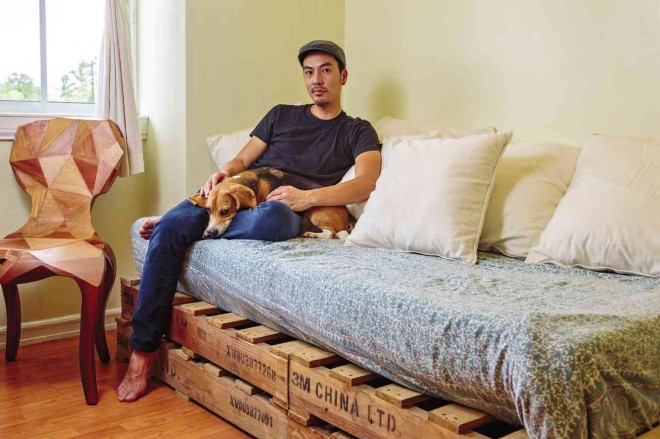
There is something peculiar about the home of Japanese designer-artist Wataru Sakuma.
Although not purely minimalist, it adheres to the Zen aesthetics of earthy textures, neutral colors, light-filled and airy rooms, simple and natural furniture with low lines, and foliage.
Like many artistically inclined homeowners, he describes his duplex as a “work in progress.”
“Since I live in Tagaytay, I like to be surrounded by nature,” he says. “This is what inspires me. I’ve used a lot of wood but I mixed them with metal, glass and paper. Still, I’m partial to natural materials.”
Colors of nature are soothing to his mind, which fuels his creativity.
Produced by friends
The shell of the duplex is spacious, with huge windows that frame the outdoors. Although he decorates the house mainly for comfort, it’s got a lot of style because the furniture, artworks and accessories were produced by his friends.
by the veins of the leaves, adorn the balcony.
Milo Naval’s warm, taupe sectional sofa invites visitors to laze around. Jinggoy Buensuceso’s metal-and-cement abstraction emphasizes the earthiness of the décor scheme. Tes Pasola’s coiled newspaper art echoes the spirals of Sakuma’s tinalak ribbon ottoman.
Stanley Ruiz’s maple clock glorifies the raw beauty of wood. Daniel Latorre Cruz’s coco lumber chair doubles as an accent piece and a stackable seater in the master bedroom. Though past its season, Tony Gonzales’ artistic calendar with floral cutouts is timeless in design.
Technical drawings, mementos of Sakuma’s collaboration with Ruiz, are framed in the bedroom. Sakuma had produced the abaca pulp for Ruiz’s speakers.
Sakuma also picked up items from a Japanese friend who runs the home décor company Beams Philippines Export Corp., such as the hat rack and the teakwood-and-iron side table.
When he visited Buensuceso’s atelier in Alfonso, Cavite, he acquired the first productions of two leaf-vein chairs for the balcony.
There were bargain finds from the roadside stores along Sta. Rosa-Tagaytay Road. The master bed, for instance, cost only P7,000.
Naturally, Sakuma injects his signature works that reflect his penchant for upcycling materials. A framed picture of Manila was crafted from pulp from boiled old newspapers. The artwork faithfully traced every road artery.
In the bedrooms, his Rebaroque chairs are based on a classic silhouette, but modernized with the use of recycled wood scraps. A vase, welded from metal GI pipes, was a prototype for Solaire’s spa.
When Typhoon “Glenda” felled trees in Tagaytay, Sakuma sawed off a santol trunk and made it into plate chargers and glass coasters.
Still, the dominance of wood is softened by indoor plants and bare, skeletal branches.
Coffee grain paper
Sakuma majored in painting and sculpture at the Memphis College of Art in America, then became an apprentice to conceptual artist Ellen Harvey in New York.
He learned to work in all media, including video and wood, except paper. “There was a course on paper, but I wasn’t interested,” he recalls.
While browsing the Internet, he came across a Japanese handmade paper-making company in Tagaytay, the Masa Ecological Development Inc. (Masaeco), that needed an artist. Since 2004, Sakuma has made the Philippines his second home.
Masaeco exports handmade paper made from salago, mulberry, banana leaves and recycled newspaper. Its bread and butter are wallpaper and window shades, which are distributed by Weitzner Ltd. in America.
Sakuma’s designs on paper products have won several Katha Awards at the Manila FAME International. His Rebaroque chair for Stonesets International garnered the Mugna Award in Transitional Design at the CebuNext in 2011.
Lately he has been traveling to Thailand as a design consultant for export companies. He collaborates with prominent Bangkok-based designer Anon Pairot, a proponent of sustainable designs.
As in his work with Masaeco, Sakuma researches on agricultural waste and finds ways to recycle them into handmade paper or a new product.
“When companies produce freeze-dried durian, a ton of shells is wasted a day. Fibers can be extracted and mixed so they can be made into paper products or small accessories such as bowls and boxes,” explains Sakuma. He has been exploring other possibilities, such as making clocks from recycled paper.
At the loft of his home, the work desk is filled with mock-ups of lamps and accessories, assembled from toothpicks, wood and styrofoam. The floor is laden with rolls of paper made with salago and mulberry and colored with coffee grains, the excess from the beans.
Thai companies can use the coffee paper for iPhone cases, bags and wallets, he says. Origami folds, studies for disposable plates and clocks, are tacked on the wall.
Sakuma once said in an interview that he was awed by the transformation process in design. “It’s amazing to see various indigenous materials being transformed into beautiful products.”